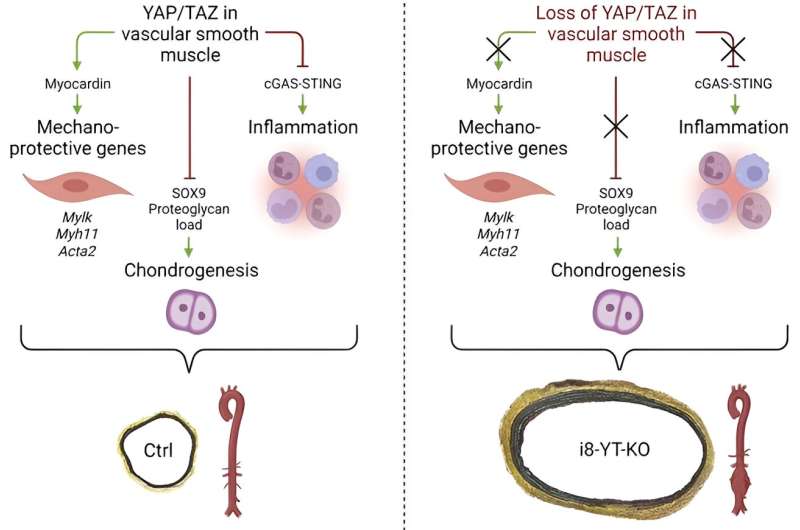This article has been reviewed according to Science X's editorial process and policies. Editors have highlighted the following attributes while ensuring the content's credibility:
fact-checked
peer-reviewed publication
trusted source
proofread
How your blood vessels tolerate high blood pressure

A research group at Lund University has studied how a molecular sensor located in the blood vessel wall, controls how the vessel compensates for high blood pressure. As we age, the sensor deteriorates, which can worsen vascular damage caused by high blood pressure and consequently lead to secondary diseases affecting the heart, brain, or other organs. In mice, the researchers demonstrate that the absence of the sensor leads to the development of aortic aneurysms. Several key findings have also been confirmed in human blood vessels.
One in five people in Sweden has high blood pressure. It is one of the major risk factors for cardiovascular disease, which is the leading cause of death worldwide. Understanding how and why high blood pressure leads to vascular damage is therefore important from both a human and socioeconomic perspective.
The muscles in the walls of blood vessels regulate the diameter of the vessels, and thus the blood flow and blood pressure, by contracting or relaxing. As we age, the vessel walls become less flexible, often resulting in an increase in blood pressure. In worst case, high blood pressure can potentially drive development of aneurysms (aortic dilation), where the vessel wall widens and is at risk of rupturing. It is one of the most urgent conditions that can occur.
With the help of medication, many people can manage their high blood pressure. However, about 15% of all patients do not respond to blood pressure medication, and for an even larger proportion, poor lifestyle habits make it difficult to control blood pressure.
"We need to understand the mechanisms behind pressure-induced vascular damage to eventually find other ways to protect the vessel wall," says Sebastian Albinsson, senior lecturer and research group leader in Molecular Vascular Physiology.
In the study published in JCI Insight, conducted on mice, the research team examined the sensor that detects higher pressure. The sensor regulates the vessel's ability to withstand the harmful effects of pressure and consists of the proteins YAP/TAZ. When these proteins decrease or disappear entirely, the smooth muscle cells in the vessel wall transform into cartilage-forming cells, making the vessels stiff, inflamed, and scarred.
"Even at normal blood pressure, the blood vessels are damaged when the sensor is absent. It might be some kind of emergency response from the cells to be able to withstand the stress, and maintain arterial integrity. But without the proteins YAP/TAZ in the vessel wall, one cannot survive," says Karl Swärd, professor of Cellular Biomechanics.
As people age, YAP/TAZ levels decrease, which can contribute to atherosclerosis and increase the risk of stroke and cognitive changes such as vascular dementia. The combination of higher blood pressure, and the reduction of the protective sensor, is a devastating combination from a cardiovascular perspective.
"The study was conducted in mice, but several key findings have been confirmed in human tissues. Among other things, we have found that YAP is greatly reduced in human aneurysm tissue, indicating that the YAP/TAZ sensor likely protects against pressure-induced vascular damage in humans as well," says Sebastian Albinsson.
Now, the researchers hope to understand why aging inhibits the sensor and how it's signaling pathways can be influenced to medically counteract the development and worsening of vascular disease. An interesting consequence of the findings is that they could explain the beneficial effect of exercise. Since the vessel wall is made up of muscles, YAP/TAZ is activated when we exercise, causing a temporary increase in blood pressure. This can prepare the vessel wall to better handle subsequent episodes of high blood pressure.
More information: Marycarmen Arévalo Martínez et al, Vascular smooth muscle–specific YAP/TAZ deletion triggers aneurysm development in mouse aorta, JCI Insight (2023). DOI: 10.1172/jci.insight.170845





















